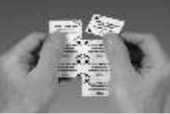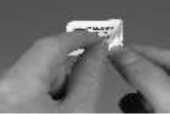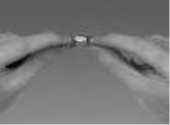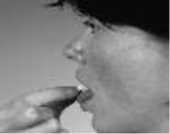Zofran Melt 8mg Tablets
S0184-0185-10-PL-PIL-13.04.2016
PATIENT INFORMATION LEAFLET
ZOFRAN® MELT 4MG AND ZOFRAN® MELT 8MG TABLETS (Ondansetron)
Read all of this leaflet carefully before you start taking this medicine because it contains important information for you.
• Keep this leaflet. You may need to read it again.
• If you have any further questions about your illness or your medicine, ask your doctor, nurse or pharmacist.
• This medicine has been prescribed for you only. Do not pass it on to others. It may harm them, even if their symptoms are the same as yours.
• If any of the side effects get serious, or if you notice any side effects not listed in this leaflet, please tell your doctor, nurse or pharmacist. This includes any possible side effects not listed in this leaflet. See section 4.
• The name of your medicine is Zofran melt 4mg or 8mg Tablets but will be referred to as Zofran melt throughout the remainder of this leaflet.
What is in this leaflet:
1. What Zofran melt is and what it is used for
2. What you need to know before you take Zofran melt
3. How to take Zofran melt
4. Possible side effects
5. How to store Zofran melt
6. Contents of the pack and other information
1. What Zofran melt is and what it is used for
Zofran melt contains a medicine called ondansetron. This belongs to a group of medicines called anti-emetics. Zofran melt is a special type of Zofran tablet that dissolves very quickly when put on top of the tongue. Zofran melt is used for:
• preventing nausea and vomiting caused by chemotherapy (in adults and children) or radiotherapy for cancer (adults only)
• preventing nausea and vomiting after surgery (adults only).
Ask your doctor, nurse or pharmacist if you would like any further explanation about these uses.
2. What you need to know before you take Zofran melt Do not take Zofran melt if:
• you are taking apomorphine (used to treat Parkinson's disease)
• you are allergic (hypersensitive) to ondansetron or any of the other ingredients in Zofran melt (listed in Section 6).
If you are not sure, talk to your doctor, nurse or pharmacist before taking Zofran melt.
Warnings and precautions
Check with your doctor, pharmacist or nurse before taking Zofran melt if:
• you have ever had heart problems (e.g. congestive heart failure which causes shortness of breath and swollen ankles)
• you have an uneven heart beat (arrhythmias)
• you are allergic to medicines similar to ondansetron, such as granisetron or palonosetron
• you have liver problems
• you have a blockage in your gut
• you have problems with the levels of salts in your blood, such as potassium, sodium and magnesium.
If you are not sure if any of the above apply to you, talk to your doctor, nurse or pharmacist before taking Zofran melt.
Other medicines and Zofran
Please tell your doctor, nurse or pharmacist if you are taking or have recently taken or might take other medicines. This includes medicines that you buy without a prescription and herbal medicines. This is because Zofran can affect the way some medicines work. Also some other medicines can affect the way Zofran works.
In particular, tell your doctor, nurse or pharmacist if you are taking any of the following medicines:
• carbamazepine or phenytoin used to treat epilepsy
• rifampicin used to treat infections such as tuberculosis (TB)
• antibiotics such as erythromycin or ketoconazole
• anti-arrhythmic medicines used to treat an uneven heart beat
• beta-blocker medicines used to treat certain heart or eye problems, anxiety or prevent migraines
• tramadol, a pain killer.
• medicines that affect the heart (such as haloperidol or methadone)
• cancer medicines (especially anthracyclines and trastuzumab).
• SSRIs (selective serotonin reuptake inhibitors) used to treat depression and/or anxiety including fluoxetine, paroxetine, sertraline, fluvoxamine, citalopram, escitalopram
• SNRIs (serotonin noradrenaline reuptake inhibitors) used to treat depression and/or anxiety including venlafaxine, duloxetine.
If you are not sure if any of the above applies to you, talk to your doctor, nurse or pharmacist before having Zofran melt.
Pregnancy and breast-feeding
It is not known if Zofran is safe during pregnancy. If you are pregnant, think you are pregnant or are planning to have a baby, ask your doctor or pharmacist for advice before taking Zofran melt.
Do not breast-feed if you are taking Zofran. This is because small amounts pass into the mother's milk. Ask your doctor or midwife for advice.
Important information about some of the ingredients of Zofran melt
• This medicine contains aspartame (which is a source of phenylalanine). If you have an inherited illness called phenylketonuria speak to your doctor before taking this medicine.
• This medicine contains sodium methylhydroxybenzoate and sodium propylhydroxybenzoate. This may cause allergic reactions (which could be delayed).
3. How to take Zofran melt
Always take Zofran melt exactly as your doctor has told you. You should check with your doctor, nurse or pharmacist if you are not sure. The dose you have been prescribed will depend on the treatment you are having.
To prevent nausea and vomiting from chemotherapy or radiotherapy
On the day of chemotherapy or radiotherapy
• the usual adult dose is 8 mg taken one or two hours before treatment and another 8 mg twelve hours after.
On the following days
• the usual adult dose is 8 mg twice a day
• this may be given for up to 5 days.
Children aged over 6 months and adolescents:
The doctor will decide the dose depending on the child's size (body surface area) or weight. Look at the label for more information.
• the usual dose for a child is up to 4 mg twice a day
• this can be given for up to 5 days.
To prevent nausea and vomiting after an operation
The usual adult dose is 16 mg before your operation
Children aged over 1 month and adolescents:
It is recommended that Zofran is given as an injection.
Patients with moderate or severe liver problems
The total daily dose should not be more than 8 mg.
How to remove Zofran melt from the blister and take the medicine
• Do not take a Zofran melt tablet out from its blister until you are ready to take it.
• Before you take the Zofran melt make sure the foil packaging has not been pierced.
• Important: Do not try to push Zofran melt through the foil top like a usual tablet. This is because Zofran melt is fragile and will break.

1. Tear off one Zofran melt in its blister.

2. Peel back the foil, as shown by the arrow.
PLEASE TURN OVER

3. Gently push out the Zofran melt tablet.

4. Place the Zofran melt on top of the tongue. It will dissolve very quickly. Then you can swallow as normal.
PL 33902/0184 PL 33902/0185
POM
Zofran melt should start to work within one or two hours of taking a dose.
If you are sick (vomit) within one hour of taking a dose
• take the same dose again
• otherwise, do not take more Zofran melt than the label says.
If you continue to feel sick, tell your doctor or nurse.
If you take more Zofran melt than you should
If you or your child take more Zofran than you should, talk to a doctor or go to a hospital straight away. Take the medicine pack with you.
If you forget to take Zofran melt
If you miss a dose and feel sick or vomit:
• take a Zofran melt as soon as possible, then
• take your next tablet at the usual time (as shown on the label)
• do not take a double dose to make up for a forgotten dose.
If you miss a dose but do not feel sick
• take the next dose as shown on the label
• do not take a double dose to make up for a forgotten dose.
4. Possible side effects
Like all medicines, Zofran melt can cause side effects, although not everybody gets them.
Allergic reactions
If you have an allergic reaction, stop taking it and see a doctor straight away. The signs may include:
• sudden wheezing and chest pain or chest tightness
• swelling of your eyelids, face, lips, mouth or tongue
• skin rash - red spots or lumps under your skin (hives) anywhere on your body
• collapse.
Other side effects include:
Very common (may affect more than 1 in 10 people)
• headache.
Reporting of side effects
If you get any side effects, talk to your doctor, pharmacist or nurse. This includes any possible side effects not listed in this leaflet. You can also report side effects directly via the Yellow Card Scheme at: www.mhra.gov.uk/yellowcard.
By reporting side effects you can help provide more information on the safety of this medicine.
5. How to store Zofran melt
• Keep out of the sight and reach of children.
• Do not use Zofran melt after the expiry date which is stated on the pack after ‘Exp'.
• Do not store Zofran melt above 30°C.
• Zofran melt should only be taken out of the blister immediately before taking it.
• If your doctor tells you to stop taking Zofran melt, it is important to return any which are left over to your pharmacist.
6. Contents of the pack and other information What Zofran melt contains
• The active ingredient is ondansetron. Each Zofran melt contains ondansetron 4 mg or 8 mg.
• The other ingredients are gelatin, mannitol, aspartame, sodium methylhydroxybenzoate, sodium propylhydroxybenzoate, strawberry flavour.
What Zofran melt looks like and contents of the pack
White, round, plano-convex, freeze dried, fast dispersing tablet, with no markings on either side. Each pack contains 10 Zofran melt units.
Manufactured by: Aspen Bad Oldesloe GmbH Industriestrasse 32-36 23843 Bad Oldesloe, Germany
Product Licence holder: Sam Pharma Ltd. Unit 20, Irving Way, Hendon, London NW9 6AQ.
Procured from within the EU and repackaged by Amimed Direct Ltd. London NW9 6AQ.
Zofran melt 4mg Tablets Zofran melt 8mg Tablets
Leaflet revised 13/04/2016
Zofran® melt is a registered trademark of Glaxo Group Ltd.
S0184-0185-10-PL-PIL-13.04.2016
Common (may affect up to 1 in 10 people)
• a feeling of warmth or flushing
• constipation
• changes to liver function test results (if you take Zofran melt with a medicine called cisplatin, otherwise this side effect is uncommon).
Uncommon (may affect up to 1 in 100 people)
• hiccups
• low blood pressure, which can make you feel faint or dizzy
• uneven heart beat
• chest pain
• fits
• unusual body movements or shaking.
Rare (may affect up to 1 in 1,000 people)
• feeling dizzy or light headed
• blurred vision
• disturbance in heart rhythm (sometimes causing a sudden loss of consciousness).
Very rare (may affect up to 1 in 10,000 people)
• poor vision or temporary loss of eyesight, which usually comes back within 20 minutes.